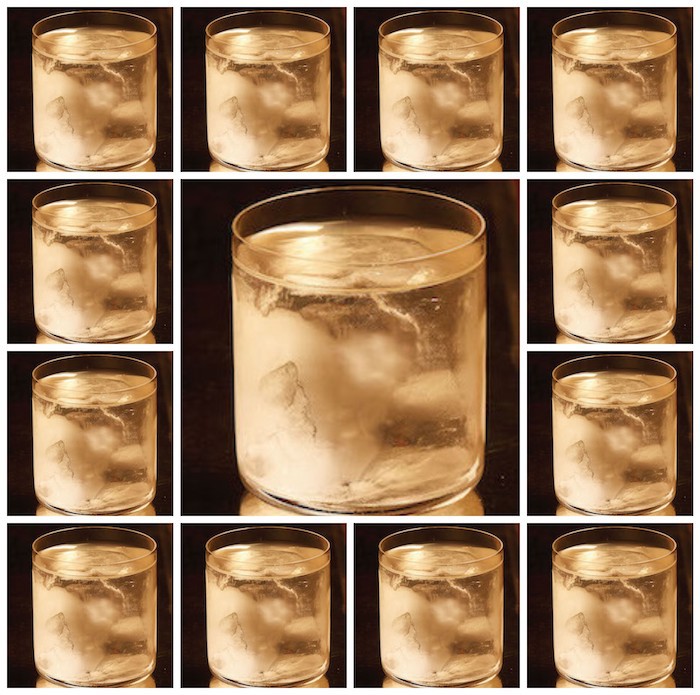
Kevin Armstrong, asks whether bars have run out of ideas when it comes to how their serves appear.
I’ve been thinking this for a while now, but so many of our cocktails are starting to look the same. Take the wafer-thin tumbler of clear liquid that surrounds a machine-cut ice block. Yes, the hue might vary, the ice block might be stamped or printed, and there might be room for an apologetic garnish, but this template serve is everywhere. Somehow it seems we have reached cocktail presentation uniformity. And – I don’t know if this is because they look the same – but to my palate, many of these cocktails are starting to taste the same too.
The minimalist trend, beginning eight or so years ago, and shaped by highly acclaimed venues such as Three Sheets, Scout, Tayer + Elementary and Coupette, has, like a wand of influence, worked its magic, to the point many bars around the country – if not the world – now default to this presentation style.
This trend has reached new levels of traction. For venues of The World’s 50 Best Bars, it feels like this style has almost become a prerequisite. This autumn, during one of the many guest shifts I attended in Europe, seven of the nine menu drinks were offered in this very same format: tumbler, ice block, clear cocktail. If you lined them up and tried to pair them against their menu descriptions, you’d struggle to distinguish one from another.
At the very heart of this style we have what has become known as ‘craft ice’. It feels a little like if you have aspirations to be a great bar, the shortcut is buying some 5cm x 5cm x 5cm clear ice blocks and getting your hands on some Nude tumblers. As if no serious cocktail programme is complete without them.
The term ‘craft ice’ (which admittedly has its roots in the US) is increasingly a misnomer. Bulk blocks produced in a warehouse are hardly the hand-chiselled ice that laid the foundations of this trend. It is a long-way from the hand-shaped ice of Milk & Honey’s Red Room in the early 2000s, the ice programme of the Merchant Hotel, or the carved bar blocks seen at Shochu Lounge.
I believe that our cocktail programmes are richer for the commercialisation and availability of craft-style ice, but along with the wafer-thin tumbler, this serve has become the poster child of modern-day cocktail menus; it’s become a cookie-cutter expression of drinks making.
The ice informs the glass
And here is something you don’t hear every day – I actually like ice cubes. There is something about the way they fall and move around a glass that is lost when you have a block. Blocks are, of course, beneficial to certain drinks, others less so, but it feels like we’re just a stone’s throw from getting our Mojitos served in tumblers and over a block of ice.
Ice choice has another consequence – the path it takes you down. While cubes don’t pre-determine the glass – they fit in most vessels – large-format ice blocks drastically limit the types of glassware that can be used for your drink, and the fewer options you have here, the more likely your drinks will present the same.
First, the glassware needs to be thin, or the ice blocks are obscured, and the glassware is nearly always straight sided. Glassware with any kind of medium-to-aggressive taper (either top-down or bottom-up) just doesn’t work for these kinds of large geometric cubes/blocks, not without having to hand-taper the blocks themselves. Another knock-on effect is that thinner glassware also has a tendency to break. So, if you’ve ever wondered how to reduce your breakages costs, stronger glassware is not a bad place to start.
Efficiency informs the serve
I’d argue we’ve been led further down this particular path simply because it’s efficient and easy. Serving cocktails of any kind comes with challenges: straight up drinks need to be sub-zero and warm up quickly; shaken drinks are labour intensive; highballs, unless fully pre-carbonated, can be fiddly; and both shaken drinks and highballs require the texture of the beverage to remain at their best. The path of least resistance, the easy way out, if you will, is serving a fully batched and still cocktail over a slowly diluting ice block, where neither texture nor being super-chilled are critical factors to the drink’s quality.
Liquid homogeneity
An unintended consequence of this uniformity of aesthetics, I’d venture, is an increasing uniformity of taste. A desire to achieve the look influences the liquid. Even when these cocktails use vastly different ingredients, with everything flavoured in advance, often filtered till clear and served still over ice, there is absolutely a narrowing in how they deliver. Certain production methods lend themselves more readily to this type of serve, so when faced with several drinks of this kind, it’s easy to get palate fatigue trying to pick out the differences.
The trend is dead, long live the trend
Do I like these drinks? Yes, I do. There is an elegance and finesse in their simplicity and there are countless examples of exceptional drinks to have emerged through this approach – drinks that position liquid and ingredients front and centre. It’s important we don’t give this up.
I don’t expect us to either – the tumbler-block serve is one of the flagship cocktail presentations of the minimalist movement which has pervaded over the last decade. I just can’t help thinking that it shouldn’t be as pervasive as it is, particularly when its ubiquity is now rooted in ease of service and the assumption that it’s what everyone expects. I can’t be the only one looking at this sea of similar serves and thinking it’s become boring – as if bartending has run out of ideas.


